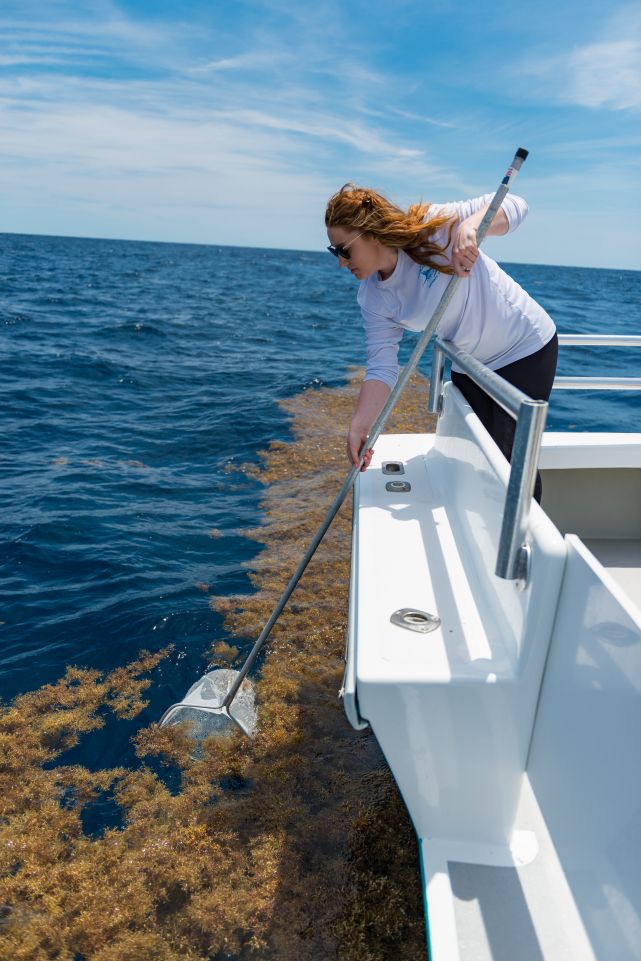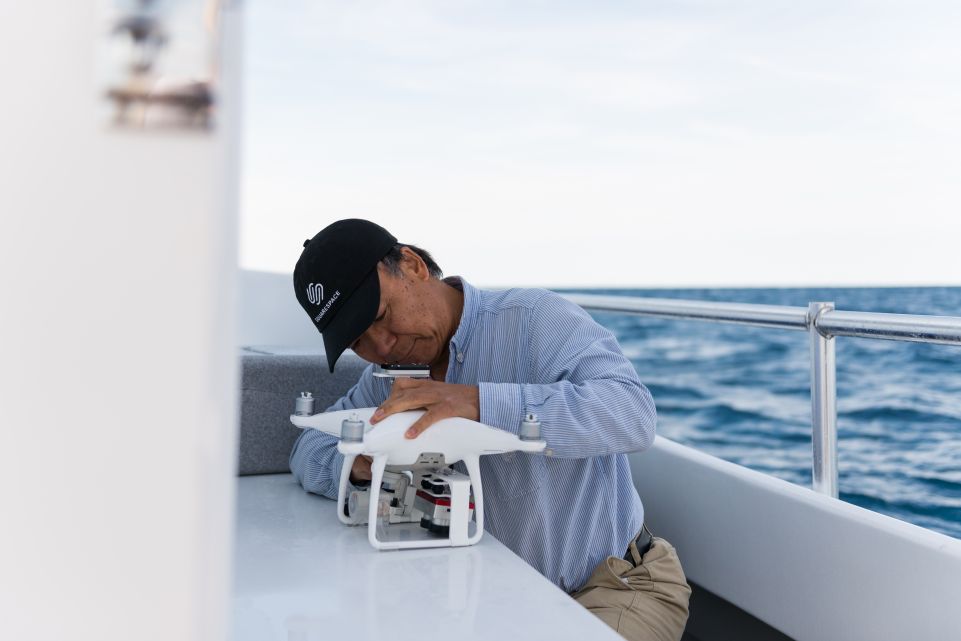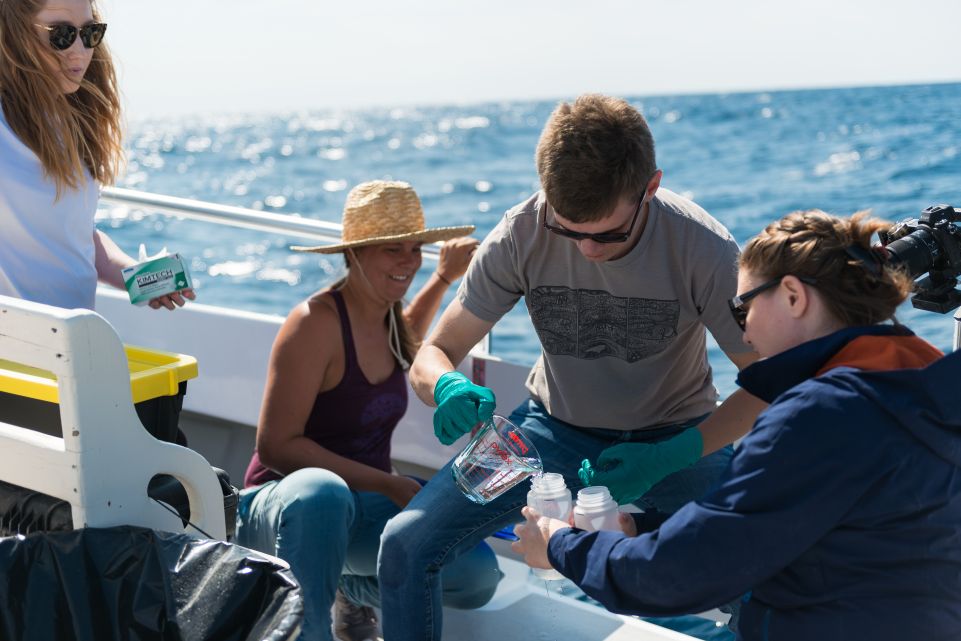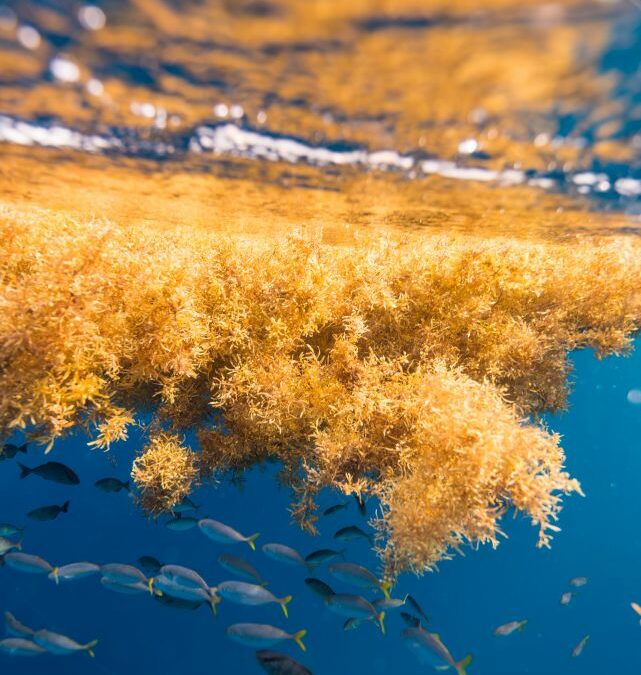Whether you are a commercial fisherman or coastal scientist, the Gulf Stream is an expansive and versatile natural resource known to generations of Outer Banks residents and visitors for its historical, ecological, or economic significance. Within the last decade, the Gulf Stream has specifically caught the attention of ocean scientists and engineers from public and private entities interested in harnessing its power to generate renewable energy for grid-scale integration and self-contained offshore centers. The North Carolina Renewable Ocean Energy Program (NCROEP), a CSI-led research initiative that attracts state and outside funding for interdisciplinary research, development, and testing of hydrokinetic energy harvesting strategies, was founded in 2010 for just this purpose.
NCROEP is a partnership including ECU, CSI, the colleges of engineering at NCSU, UNC Charlotte and NCA&T University, as well as out-of-state universities and private industry collaborators. The work is distributed across four major focal areas: Gulf Stream power assessment and device siting; improving the efficiency, maintenance and power outputs of renewable energy devices; environmental and regulatory assessment; and assisting private industry with marine hydrokinetic device field testing and assessment.
As part of the NCROEP environmental assessment, a team of scientists, students, interns and volunteer researchers from the Coastal Studies Institute recently rose with the morning sun to climb aboard the Miss Jill Louise: a local charter vessel embarking on its first research cruise to study Sargassum, the large floating mats of brown macro-algae found in the Gulf Stream and warm parts of the ocean. Led by CSI research scientist and NCROEP Associate Director, Dr. Lindsay Dubbs, and UNC-CH graduate student, Claire Johnson, the team is part of an ongoing study specifically interested in examining nutrient cycling and primary productivity within Sargassum and surrounding communities. The study addresses a fundamental role of the Gulf Stream in the open ocean environment where nitrogen is the limiting nutrient. Ultimately, the work will help scientists in the NCROEP to assess the ecological and environmental impacts that harnessing the power of the Gulf Stream for grid-scale renewable energy may have on the surrounding environment and offshore ecosystem.

The Gulf Stream is a massive, warm water surface current that flows along the continental shelf toward Cape Hatteras as part of the North Atlantic gyre system. It is an essential resource for North Carolina’s offshore fisheries due to its incredible biodiversity and pockets of productivity in an otherwise barren environment. The Stream is also a major driver of global climate and important vehicle for nutrient cycling and nitrogen fixation in the open ocean, or pelagic, environment because of the Sargassum communities found in its waters. Nitrogen is a macronutrient required by all living things; however, atmospheric nitrogen needs to be “fixed” through a series of steps to become biologically available to organisms. Because it is the limiting nutrient in the pelagic environment, any process that delivers biologically available nitrogen to the system could increase primary productivity which cascades up the food chain. The microorganisms that live on Sargassum, known as the epiphytic community, are suspected to play a critical yet vastly underestimated role in the nitrogen fixation process. Thus, the primary goal of Dubbs and Johnson’s work is to better understand just how much nitrogen is being added to the environment by the epiphytic and planktonic communities associated with the Gulf Stream’s Sargassum patches. Their work involves a series of measurements and experimental procedures conducted in the field, lab, and through geospatial analysis.

Claire Johnson is a graduate student at UNC Chapel Hill and works with Dubbs, also her academic advisor, as a research technician at CSI. Johnson’s research is specifically focused on measuring nitrogen cycling. “The marine environment is experiencing a period of rapid change. Therefore, we need to better understand nutrient movement now so we can predict how changes to these cycles will affect both the built and natural environment in the future,” Johnson explains. “We think that system-wide energy removal [from a hydrokinetic energy harvesting installation] may have an effect on the health of the Sargassum itself. This may, in turn, alter how the microbial community functions, including how much nitrogen it fixes. Thus, we are isolating the impacts of energy removal to see how changes to nitrogen fixation rates may affect the entire ecosystem.”
Sargassum is unique in the marine environment because it provides food and shelter in an area otherwise devoid of such structure. This creates essential habitat to everything from microscopic plankton up to charismatic megafauna like cetations, economically important fish, and sea turtles. To better understand the services it provides, the research team must first get a grasp on the spatial scale—or amount of sargassum present—in the Gulf Stream environment. This is where research partner and professor of Natural Sciences at Elizabeth City State University, Dr. Jinchun Yuan’s, expertise comes in to play. Multispectral imagery captured by drone will allow Yuan and the team to approximate the surface area of Sargassum patches. Because Sargassum patches are three-dimensional, this data is then combined with depth measurements taken in the field to calculate the approximate, overall biomass density of Sargassum. Researchers can then extrapolate the nitrogen fixation rates by the Sargassum community they are measuring to get a baseline estimate of how much reactive nitrogen enters the Gulf Stream environment specifically through fixation by the Sargassum.

Sargassum communities are extremely fragile and difficult to preserve once removed from their natural environment. Thus, many of the critical measurements and filtration procedures related to Johnson’s nitrogen fixation and related research are conducted immediately after collection, right onboard the vessel. The team also collects water and Sargassum samples to bring back to the lab to monitor productivity under varying degrees of turbulence, which is another potential impact posed by the presence of underwater turbines in the Gulf Stream.
The procedures conducted onboard the boat at each site serve several purposes. First, they allow researchers to isolate the three distinct communities of interest: the plankton in the water, the epiphytes living on the Sargassum, and the Sargassum itself. Then, a series of water filtration techniques and tests are conducted onboard before the samples are stored on ice for safe transport back to the lab where final measurements of gas concentrations in the samples are taken. The resulting data set will include total Sargassum biomass density, chlorophyll a to measure planktonic primary productivity, microbial DNA samples for offsite analysis, and gas concentration measurements. Back at the lab, environmental chambers, called mesocosms are created with live Sargassum, seawater, and high powered lights to simulate the offshore environment. This allows researchers to observe the samples’ productivity as it is exposed to varying degrees of turbulence in a controlled environment.

This and the additional work being conducted within the NCROEP Environmental and Regulatory Assessment is essential to minimizing and mitigating any potential impacts that marine hydrokinetic devices may have on offshore ecosystems. While utility-scale wave and current energy installations do not yet exist, ocean energy extraction has gained increasing attention as a viable component of the energy mix of the future. The Sargassum nutrient cycling and productivity research being conducted by this CSI-led, multi-university research team will be the most recent and thorough study ever conducted on this type of fixation, therefore providing valuable and novel insights to guide the future of renewable ocean energy development through the NCROEP.



 Based at the Coastal Studies Institute (CSI), the North Carolina Renewable Ocean Energy Program (NCROEP) advances inter-disciplinary marine energy solutions across UNC System partner colleges of engineering at NC State University, UNC Charlotte, and NC A&T University. Click on the links below for more information.
Based at the Coastal Studies Institute (CSI), the North Carolina Renewable Ocean Energy Program (NCROEP) advances inter-disciplinary marine energy solutions across UNC System partner colleges of engineering at NC State University, UNC Charlotte, and NC A&T University. Click on the links below for more information. ECU's Integrated Coastal Programs (ECU ICP) is a leader in coastal and marine research, education, and engagement. ECU ICP includes the Coastal Studies Institute, ECU's Department of Coastal Studies, and ECU Diving and Water Safety.
ECU's Integrated Coastal Programs (ECU ICP) is a leader in coastal and marine research, education, and engagement. ECU ICP includes the Coastal Studies Institute, ECU's Department of Coastal Studies, and ECU Diving and Water Safety. The ECU Outer Banks campus is home to the Coastal Studies Institute.
The ECU Outer Banks campus is home to the Coastal Studies Institute.

